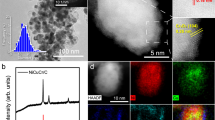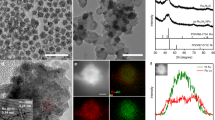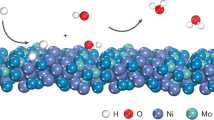Abstract
The hydroxide exchange membrane fuel cell (HEMFC) is a promising energy conversion technology but is limited by the need for platinum group metal (PGM) electrocatalysts, especially for the hydrogen oxidation reaction (HOR). Here we report a Ni-based HOR catalyst that exhibits an electrochemical surface area-normalized exchange current density of 70 μA cm–2, the highest among PGM-free catalysts. The catalyst comprises Ni nanoparticles embedded in a nitrogen-doped carbon support. According to X-ray and ultraviolet photoelectron spectroscopy as well as H2 chemisorption data, the electronic interaction between the Ni nanoparticles and the support leads to balanced hydrogen and hydroxide binding energies, which are the likely origin of the catalyst’s high activity. PGM-free HEMFCs employing this Ni-based HOR catalyst give a peak power density of 488 mW cm–2, up to 6.4 times higher than previous best-performing analogous HEMFCs. This work demonstrates the feasibility of efficient PGM-free HEMFCs.
This is a preview of subscription content, access via your institution
Access options
Access Nature and 54 other Nature Portfolio journals
Get Nature+, our best-value online-access subscription
$29.99 / 30 days
cancel any time
Subscribe to this journal
Receive 12 print issues and online access
$259.00 per year
only $21.58 per issue
Buy this article
- Purchase on Springer Link
- Instant access to full article PDF
Prices may be subject to local taxes which are calculated during checkout





Similar content being viewed by others
Data availability
All data are available in the main text and the Supplementary Information, and source data are deposited in Zenodo repository (https://doi.org/10.5281/zenodo.5885289)51. Source data are provided with this paper.
References
Setzler, B. P., Zhuang, Z., Wittkopf, J. A. & Yan, Y. Activity targets for nanostructured platinum-group-metal-free catalysts in hydroxide exchange membrane fuel cells. Nat. Nanotechnol. 11, 1020–1025 (2016).
Thompson, S. T., Peterson, D., Ho, D. & Papageorgopoulos, D. Perspective—the next decade of AEMFCs: near-term targets to accelerate applied R&D. J. Electrochem. Soc. 167, 084514 (2020).
Wang, Y. et al. Synergistic Mn–Co catalyst outperforms Pt on high-rate oxygen reduction for alkaline polymer electrolyte fuel cells. Nat. Commun. 10, 1506 (2019).
Santori, P. G. et al. High performance FeNC and Mn-oxide/FeNC layers for AEMFC cathodes. J. Electrochem. Soc. 167, 134505 (2020).
Peng, X. et al. High-performing PGM-free AEMFC cathodes from carbon-supported cobalt ferrite nanoparticles. Catalysts 9, 264 (2019).
Wang, J. et al. Poly(aryl piperidinium) membranes and ionomers for hydroxide exchange membrane fuel cells. Nat. Energy 4, 392–398 (2019).
Firouzjaie, H. A. & Mustain, W. E. Catalytic advantages, challenges, and priorities in alkaline membrane fuel cells. ACS Catal. 10, 225–234 (2019).
Gu, S. et al. An efficient Ag–ionomer interface for hydroxide exchange membrane fuel cells. Chem. Commun. 49, 131–133 (2013).
Zhuang, Z. et al. Nickel supported on nitrogen-doped carbon nanotubes as hydrogen oxidation reaction catalyst in alkaline electrolyte. Nat. Commun. 7, 10141 (2016).
Yang, Y. et al. Enhanced electrocatalytic hydrogen oxidation on Ni/NiO/C derived from a nickel-based metal–organic framework. Angew. Chem. Int. Ed. 58, 10644–10649 (2019).
Yang, F. et al. Boosting hydrogen oxidation activity of Ni in alkaline media through oxygen-vacancy-rich CeO2/Ni heterostructures. Angew. Chem. Int. Ed. 58, 14179–14183 (2019).
Davydova, E., Zaffran, J., Dhaka, K., Toroker, M. & Dekel, D. Hydrogen oxidation on Ni-based electrocatalysts: the effect of metal doping. Catalysts 8, 454 (2018).
Oshchepkov, A. G. et al. Nanostructured nickel nanoparticles supported on vulcan carbon as a highly active catalyst for the hydrogen oxidation reaction in alkaline media. J. Power Sources 402, 447–452 (2018).
Ni, W. et al. Efficient hydrogen oxidation catalyzed by strain-engineered nickel nanoparticles. Angew. Chem. Int. Ed. 59, 10797–10801 (2020).
Ni, W. et al. Ni3N as an active hydrogen oxidation reaction catalyst in alkaline medium. Angew. Chem. Int. Ed. 58, 7445–7449 (2019).
Durst, J. et al. New insights into the electrochemical hydrogen oxidation and evolution reaction mechanism. Energy Environ. Sci. 7, 2255–2260 (2014).
Zheng, J., Sheng, W., Zhuang, Z., Xu, B. & Yan, Y. Universal dependence of hydrogen oxidation and evolution reaction activity of platinum-group metals on pH and hydrogen binding energy. Sci. Adv. 2, e1501602 (2016).
Rebollar, L. et al. “Beyond adsorption” descriptors in hydrogen electrocatalysis. ACS Catal. 10, 14747–14762 (2020).
Subbaraman, R. et al. Enhancing hydrogen evolution activity in water splitting by tailoring Li+–Ni(OH)2–Pt interfaces. Science 334, 1256–1260 (2011).
Subbaraman, R. et al. Trends in activity for the water electrolyser reactions on 3d M(Ni,Co,Fe,Mn) hydr(oxy)oxide catalysts. Nat. Mater. 11, 550–557 (2012).
Strmcnik, D. et al. Improving the hydrogen oxidation reaction rate by promotion of hydroxyl adsorption. Nat. Chem. 5, 300–306 (2013).
Sheng, W. et al. Correlating hydrogen oxidation and evolution activity on platinum at different pH with measured hydrogen binding energy. Nat. Commun. 6, 5848 (2015).
Zheng, J., Nash, J., Xu, B. & Yan, Y. Perspective—towards establishing apparent hydrogen binding energy as the descriptor for hydrogen oxidation/evolution reactions. J. Electrochem. Soc. 165, H27–H29 (2018).
Giles, S. A. et al. Recent advances in understanding the pH dependence of the hydrogen oxidation and evolution reactions. J. Catal. 367, 328–331 (2018).
Ledezma-Yanez, I. et al. Interfacial water reorganization as a pH-dependent descriptor of the hydrogen evolution rate on platinum electrodes. Nat. Energy 2, 17031 (2017).
Ryu, J. & Surendranath, Y. Tracking electrical fields at the Pt/H2O interface during hydrogen catalysis. J. Am. Chem. Soc. 141, 15524–15531 (2019).
Rebollar, L., Intikhab, S., Snyder, J. D. & Tang, M. H. Kinetic isotope effects quantify pH-sensitive water dynamics at the Pt electrode interface. J. Phys. Chem. Lett. 11, 2308–2313 (2020).
Dekel, D. R. Unraveling mysteries of hydrogen electrooxidation in anion exchange membrane fuel cells. Curr. Opin. Electrochem. 12, 182–188 (2018).
Tian, X., Zhao, P. & Sheng, W. Hydrogen evolution and oxidation: mechanistic studies and material advances. Adv. Mater. 31, e1808066 (2019).
Lu, S. & Zhuang, Z. Investigating the influences of the adsorbed species on catalytic activity for hydrogen oxidation reaction in alkaline electrolyte. J. Am. Chem. Soc. 139, 5156–5163 (2017).
McCrum, I. T. & Koper, M. T. M. The role of adsorbed hydroxide in hydrogen evolution reaction kinetics on modified platinum. Nat. Energy 5, 891–899 (2020).
Feng, Z. et al. Role of hydroxyl species in hydrogen oxidation reaction: a DFT study. J. Phys. Chem. C. 123, 23931–23939 (2019).
Dahal, A. & Batzill, M. Graphene–nickel interfaces: a review. Nanoscale 6, 2548–2562 (2014).
Luo, M. et al. PdMo bimetallene for oxygen reduction catalysis. Nature 574, 81–85 (2019).
Kambe, T. et al. Redox control and high conductivity of nickel bis(dithiolene) complex π-nanosheet: a potential organic two-dimensional topological insulator. J. Am. Chem. Soc. 136, 14357–14360 (2014).
Dou, J. H. et al. Signature of metallic behavior in the metal–organic frameworks M3(hexaiminobenzene)2 (M = Ni, Cu). J. Am. Chem. Soc. 139, 13608–13611 (2017).
Hammer, B. & Nørskov, J. K. Theoretical surface science and catalysis—calculations and concepts. Adv. Catal. 45, 71–129 (2000).
Doyle, R. L., Godwin, I. J., Brandon, M. P. & Lyons, M. E. Redox and electrochemical water splitting catalytic properties of hydrated metal oxide modified electrodes. Phys. Chem. Chem. Phys. 15, 13737–13783 (2013).
Qian, X. M. et al. A pulsed field ionization photoelectron–photoion coincidence study of the dissociative photoionization process D2O+hν→OD++D+e−. Chem. Phys. Lett. 353, 19–26 (2002).
Li, J. F. et al. Shell-isolated nanoparticle-enhanced Raman spectroscopy. Nature 464, 392–395 (2010).
Deng, S. et al. Insight into the hydrogen oxidation electrocatalytic performance enhancement on Ni via oxophilic regulation of MoO2. J. Energy Chem. 54, 202–207 (2021).
Gao, L. et al. A nickel nanocatalyst within a h-BN shell for enhanced hydrogen oxidation reactions. Chem. Sci. 8, 5728–5734 (2017).
Yang, F. et al. Enhanced HOR catalytic activity of PGM-free catalysts in alkaline media: the electronic effect induced by different heteroatom doped carbon supports. J. Mater. Chem. A 7, 10936–10941 (2019).
Giles, S. A., Yan, Y. & Vlachos, D. G. Effect of substitutionally doped graphene on the activity of metal nanoparticle catalysts for the hydrogen oxidation reaction. ACS Catal. 9, 1129–1139 (2018).
Yang, Y. et al. High-loading composition-tolerant Co–Mn spinel oxides with performance beyond 1 W/cm2 in alkaline polymer electrolyte fuel cells. ACS Energy Lett. 4, 1251–1257 (2019).
Wang, T. et al. Weakening hydrogen adsorption on nickel via interstitial nitrogen doping promotes bifunctional hydrogen electrocatalysis in alkaline solution. Energy Environ. Sci. 12, 3522–3529 (2019).
Song, F. et al. Interfacing nickel nitride and nickel boosts both electrocatalytic hydrogen evolution and oxidation reactions. Nat. Commun. 9, 4531 (2018).
Miller, H. A. et al. A Pd/C-CeO2 anode catalyst for high-performance platinum-free anion exchange membrane fuel cells. Angew. Chem. Int. Ed. 55, 6004–6007 (2016).
Wade, C. R. & Dinca, M. Investigation of the synthesis, activation, and isosteric heats of CO2 adsorption of the isostructural series of metal–organic frameworks M3(BTC)2 (M = Cr, Fe, Ni, Cu, Mo, Ru). Dalton Trans. 41, 7931–7938 (2012).
Sheng, W. C., Gasteiger, H. A. & Shao-Horn, Y. Hydrogen oxidation and evolution reaction kinetics on platinum: acid vs alkaline electrolytes. J. Electrochem. Soc. 157, B1529–B1536 (2010).
Ni, W. et al. An efficient nickel hydrogen oxidation catalyst for hydroxide exchange membrane fuel cells. Source data at https://doi.org/10.5281/zenodo.5885289 (2022).
Acknowledgements
W.N. and X.H. acknowledge the financial support of EPFL; T.W. and Y.Y. acknowledge the financial support of the US Department of Energy, Advanced Research Projects Agency-Energy (award nos. DE-AR0000771, DE-AR0000805, DE-AR0001034 and DE-AR0001149); F.H. and J.S.L. acknowledge the financial support of the European Research Council under the European Union’s Horizon 2020 research and innovation program (starting grant CATACOAT, no. 758653) as well as the Swiss National Science Foundation (grant no. PYAPP2_15428); S.L. acknowledges the Marie Skłodowska-Curie Fellowship (grant no. 838367). We thank P. A. Schouwink (EPFL) for assistance with XRD measurements.
Author information
Authors and Affiliations
Contributions
W.N. designed and synthesized all the catalysts, performed electrochemical measurements and characterizations; T.W. assembled the MEAs and performed the fuel cell measurements; F.H. performed the chemisorption experiments and analysed the data with J.S.L.; A.K. performed the UPS measurements and analysed the data with A.S.; S.L. and W.N. performed the in situ Raman experiments; L.Y. performed the four-probe conductivity measurements; W.N. and X.H. wrote the paper, with input from all the other co-authors. Y.Y. and X.H. directed the research.
Corresponding authors
Ethics declarations
Competing interests
The authors declare no competing interests.
Peer review
Peer review information
Nature Materials thanks Frédéric Jaouen and Sanjeev Mukerjee for their contribution to the peer review of this work.
Additional information
Publisher’s note Springer Nature remains neutral with regard to jurisdictional claims in published maps and institutional affiliations.
Supplementary information
Supplementary Information
Supplementary Notes, Figs. 1–32 and Tables 1–7.
Source data
Source Data Fig. 2
Statistical source data.
Source Data Fig. 3
Statistical source data.
Source Data Fig. 4
Statistical source data.
Source Data Fig. 5
Statistical source data.
Rights and permissions
About this article
Cite this article
Ni, W., Wang, T., Héroguel, F. et al. An efficient nickel hydrogen oxidation catalyst for hydroxide exchange membrane fuel cells. Nat. Mater. 21, 804–810 (2022). https://doi.org/10.1038/s41563-022-01221-5
Received:
Accepted:
Published:
Issue Date:
DOI: https://doi.org/10.1038/s41563-022-01221-5
This article is cited by
-
Unveiling the nature of Pt-induced anti-deactivation of Ru for alkaline hydrogen oxidation reaction
Nature Communications (2024)
-
Implanting oxophilic metal in PtRu nanowires for hydrogen oxidation catalysis
Nature Communications (2024)
-
Tuning the apparent hydrogen binding energy to achieve high-performance Ni-based hydrogen oxidation reaction catalyst
Nature Communications (2024)
-
Covalently Bonded Ni Sites in Black Phosphorene with Electron Redistribution for Efficient Metal-Lightweighted Water Electrolysis
Nano-Micro Letters (2024)
-
Progress and prospect of Pt-based catalysts for electrocatalytic hydrogen oxidation reactions
Nano Research (2024)



